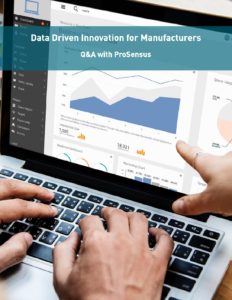Q&A with ProSensus
Prior to the American Manufacturing Summit 2019, we spoke with ProSensus to discuss data-driven innovation and how leveraging technology can give manufacturers a competitive edge in an ever-changing landscape. In this eBook, we discuss how manufacturers can achieve their big data objectives with multivariate analysis, how they can leverage their data to accelerate their product development efforts, and how they can achieve quality control with machine vision.
This is an excerpt from the Q&A Generis did with ProSensus:
“How can manufacturers achieve their big data objectives and optimize plant performance with multivariate analysis?
“Big Data” is the new manufacturing buzzword.
Companies across various industries are working hard to collect more data across their production lines. But what are companies doing with this data? At the American Biomanufacturing Summit 2018, an executive told ProSensus: “My data doubles every 15 months but my knowledge does not.”
ProSensus uses multivariate analysis (MVA) to integrate the “Big Data” initiatives into actual process insights that are otherwise left uncovered.
A key aspect of multivariate analysis is the ability to combine data from various sources such as raw material information, laboratory data, and process data from a variety of process steps to product quality. By creating a multivariate model that encompasses multiple sources of variation, manufacturers can gain real insights from their historical data to improve quality, increase yield and reduce costs.
The technical principle behind MVA is that variation in most datasets is driven by only a small set of independent factors. Therefore, the purpose of MVA is to reduce the number of variables recorded in a dataset to a small number of independent factors that are capable of explaining the variance in the data and that can later be manipulated for process optimization.
“If you can’t model a process, you don’t understand it. If you don’t understand it, you can’t optimize it.” – AspenTech Founder”
Questions discussed:
- How can manufacturers achieve their big data objectives and optimize plant performance with multivariate analysis?
- How can companies leverage their data to accelerate their product development efforts?
- How can data enable decision making?
- How can manufacturers achieve quality control with machine vision?
- What are the minimum data requirements to start a project with ProSensus?
- Why do manufacturers choose to work with ProSensus?
Click through to read the full Q&A here.

%20(1).png?width=773&height=112&name=Generis%20Logo%20full%20Colour%20(Large)%20(1).png)



